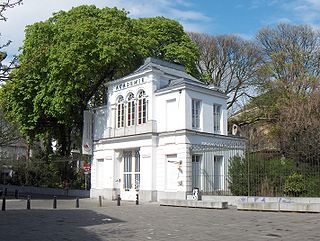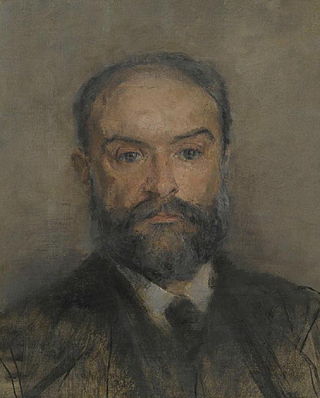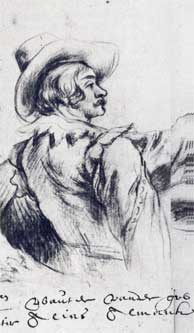
Egide Charles Gustave, Baron Wappers was a Belgian painter. His work is generally considered to be Flemish and he signed his work with the Dutch form of his name, Gustaaf Wappers.

The Royal Museums of Fine Arts of Belgium are a group of art museums in Brussels, Belgium. They include six museums: the Oldmasters Museum, the Magritte Museum, the Fin-de-Siècle Museum, the Modern Museum, the Antoine Wiertz Museum and the Constantin Meunier Museum.

The Royal Academy of Fine Arts Antwerp is an art academy located in Antwerp, Belgium. It is one of the oldest of its kind in Europe. It was founded in 1663 by David Teniers the Younger, painter to the Archduke Leopold Wilhelm and Don Juan of Austria. Teniers was master of the Guild of St Luke—which embraced arts and some handicrafts—and petitioned Philip IV of Spain, then master of the Spanish Netherlands, to grant a royal charter to establish a Fine Arts Academy in Antwerp. It houses the Antwerp Fashion Academy.

The Museum of Fine Arts an art museum in Ghent, Belgium, is situated at the East side of the Citadelpark.

Périclès Pantazis was a major Greek impressionist painter of the 19th century who gained a great reputation as an artist initially in Belgium.

Wouter Pietersz. Crabeth II was a Dutch Golden Age painter.

The Royal Flemish Academy of Belgium for Science and the Arts is an independent learned society of science and arts of the Flemish Community in Belgium. It is one of Belgium's numerous academies and traces its origin to 1772 when the Imperial and Royal Academy of Brussels was founded by empress Maria Theresia.
Jef Geys was a Belgian artist born in Leopoldsburg, Belgium. Geys is known for his photography, painting, sculpture, films, installation art, publishing activities, and experimentation in art education.

Catherine de Zegher is a Belgian curator and a modern and contemporary art historian. She has a degree in art history and archaeology from the University of Ghent.
The Royal Academy of Science, Letters and Fine Arts of Belgium is the independent learned society of science and arts of the French Community of Belgium. One of Belgium's numerous academies, it is the French-speaking counterpart of the Royal Flemish Academy of Belgium for Science and the Arts. In 2001 both academies founded a joint association for the purpose of promoting science and arts on an international level: The Royal Academies for Science and the Arts of Belgium (RASAB). All three institutions are located in the same building, the Academy Palace in Brussels.

Jean-Joseph Delvin was a Belgian painter who specialized in scenes with animals.

The Old Folks Sing, the Young Folks Chirp is a 1638–1640 oil-on-canvas painting by the Flemish artist Jacob Jordaens, now in the Royal Museum of Fine Arts Antwerp. He painted several works with this title, a Dutch proverb – this is the earliest of them, whilst another is now in Valenciennes.

The Blind Man is a 1910 painting by the Flemish artist Gustave Van de Woestijne, now in the Royal Museum for Fine Arts, Antwerp. It is one of a series of portraits of farm workers he produced in Leuven and shows the influence of what were then called the 'Flemish Primitives', such as Rogier van der Weyden's Portrait of Philip van Croy.

Gaston and His Sister is a 1923 Expressionist oil on canvas painting by the Flemish artist Gustave Van de Woestijne, now in the Royal Museum of Fine Arts, Antwerp.
16th September is a 1956 painting by René Magritte, probably produced in 1956. It is now in the Royal Museum of Fine Arts, Antwerp, which bought it directly from the artist. The painting depicts a tree surrounded by empty space with rocks, and near the middle of the tree the Moon is shown.

The Joiners' Guild Altarpiece is an altarpiece by Quentin Matsys, executed c. 1511, produced for the eponymous guild in the aftermath of its split from the Coopers' Guild in 1497. It is now in the Royal Museum of Fine Arts, Antwerp. It is sometimes also known as the Passion Altarpiece or the Martyrdom Altarpiece after the scenes of the martyrdoms of John the Baptist and John the Evangelist on the side panels. Both these saints were patrons of carpenters and also appeared in grisaille on the outside of the side panels. The central panel shows the Lamentation over the Dead Christ.

The Prodigal Son is a 1536 Mannerist oil on oak panel painting by the Brabant painter Jan Sanders van Hemessen. It shows the New Testament parable of the Prodigal Son and has been in the collections of the Royal Museums of Fine Arts of Belgium since 1881.

Paul Jozef de Cock was a Flemish architect and painter.

Portrait of Stephan Geraedts, Husband of Isabella Coymans is a late oil on canvas painting by the Dutch Golden Age painter Frans Hals, made when the artist was about 70. The painting is one of a pendant pair of wedding portraits, now separeted. Hals probably painted the present portrait, Stephanus Geraerdts', an alderman of Haarlem, which was designed to be on the left, and the accompanying portrait of his wife Isabella Coymans around 1650–1652, six or seven years after their marriage in 1644. Isabella's portrait is now in a private collection in Paris.

Self-Portrait is an oil-on-canvas painting by the French Neoclassical artist Jean-Auguste-Dominique Ingres. The painting measures 25.2 x 20.9 inches and is part of the permanent collection of the Royal Museum of Fine Arts in Antwerp. This painting is one of the last portraits by Ingres.

















